Do you have a question about the Coleman Gas Barbecue and is the answer not in the manual?
Describes hazards for outdoor use and risks for children.
Warns about moving the lit grill and keeping the area clear of flammables.
Appliance not for RV/boat. Follow safety rules before each use.
Electrical grounding instructions and precautions for using cords.
Applies to L.P. grills piped to gas. Natural gas only for factory-equipped grills.
L.P. grills cannot be converted to natural gas. Piping system must meet codes.
Grill equipped with Type 1 coupling nut. Do not connect to other cylinder types.
Do not insert foreign objects into valve outlet; risk of leak, explosion, fire, injury, death.
Cylinders must be stored outdoors, out of reach of children.
Do not adjust regulator; could cause injury or damage. Keep vent hole clean.
Never store spare LP cylinder under grill or near heat sources; never fill beyond 80%.
Handle full cylinder with care; gas is under high pressure.
Purging and filling must be done by trained personnel; failure can cause explosion, fire, injury, death.
After purging/filling, do not insert POL plug. Use provided cap. Close valve before returning.
Connect cylinder outdoors only. Follow directions on tags.
Connection requires extra turn. Tighten by hand only. Do not use tools.
No smoking, no ignition sources during test. Perform test outdoors only.
Inspect hose before each use. Replace if damaged. Ensure hose is not kinked.
Follow safety steps before each use to prevent fire or hazards.
Do not add charcoal or lighting fluid.
Open lid first. Check knobs are off. Turn on fuel. Do not stand over grill.
Steps for using the built-in igniter to light the burner.
Instructions for lighting the grill using a long wooden match.
Steps for using the built-in igniter to light the burner.
Instructions for lighting the grill using a long wooden match.
Steps for using the igniter to light the side burner.
Instructions for lighting the side burner with a match.
Do not touch hot parts with bare hands. Use protective gloves. Turn off fuel supply.
Keep area clean. Do not obstruct airflow. Grill becomes hot; use gloves.
How to season the grill before first use or after storage.
How to visually check the burner flame for proper operation.
Guidance on using high, medium, and low flame settings for various foods.
Never leave cooking food unattended; stand to the side when opening lid.
Tips for preparing various foods like meat, poultry, fish, and using sauces.
Procedures to follow if a grease fire occurs on the grill.
Cooking with heat source directly below food.
Cooking food away from the direct heat source.
Cooking two foods at once with different temperature settings.
Using wood chips or other flavorings for smoking food.
Instructions for cleaning venturi tubes to prevent blockages and ensure heat output.
Clean when cool and fuel supply is off. Do not use self-cleaning oven.
List of recommended materials for cleaning grill components.
Specific cleaning instructions for burners, castings, stainless steel, orifices.
Never operate grill without orifices in valves; risk of fire.
Instructions for cleaning cooking grids and rock grates.
How to clean and replace porcelain coated heat tents.
Use care when moving; collision can cause injury.
Proper technique for lifting and moving the grill.
Check gas connections for leaks and venturi alignment after moving.
Cleaning, oiling burner, and storing the grill properly.
Ensure gas is turned off at the cylinder valve when the grill is not in use.
How to test the igniter system for spark and troubleshoot issues.
Lists causes and solutions for burner ignition failures.
Lists causes and solutions for yellow or irregular burner flames.
Lists causes and solutions for flames extinguishing or uneven heating.
Lists causes and solutions for excessive grill heat.
Solutions for fires occurring at gas connections.
Solutions for flames appearing behind control panel.
Importance of proper purging for new or exchanged LP gas cylinders.
Explains flow limiting device activation and proper connection order.
Describes hazards for outdoor use and risks for children.
Warns about moving the lit grill and keeping the area clear of flammables.
Appliance not for RV/boat. Follow safety rules before each use.
Electrical grounding instructions and precautions for using cords.
Applies to L.P. grills piped to gas. Natural gas only for factory-equipped grills.
L.P. grills cannot be converted to natural gas. Piping system must meet codes.
Grill equipped with Type 1 coupling nut. Do not connect to other cylinder types.
Do not insert foreign objects into valve outlet; risk of leak, explosion, fire, injury, death.
Cylinders must be stored outdoors, out of reach of children.
Do not adjust regulator; could cause injury or damage. Keep vent hole clean.
Never store spare LP cylinder under grill or near heat sources; never fill beyond 80%.
Handle full cylinder with care; gas is under high pressure.
Purging and filling must be done by trained personnel; failure can cause explosion, fire, injury, death.
After purging/filling, do not insert POL plug. Use provided cap. Close valve before returning.
Connect cylinder outdoors only. Follow directions on tags.
Connection requires extra turn. Tighten by hand only. Do not use tools.
No smoking, no ignition sources during test. Perform test outdoors only.
Inspect hose before each use. Replace if damaged. Ensure hose is not kinked.
Follow safety steps before each use to prevent fire or hazards.
Do not add charcoal or lighting fluid.
Open lid first. Check knobs are off. Turn on fuel. Do not stand over grill.
Steps for using the built-in igniter to light the burner.
Instructions for lighting the grill using a long wooden match.
Steps for using the built-in igniter to light the burner.
Instructions for lighting the grill using a long wooden match.
Steps for using the igniter to light the side burner.
Instructions for lighting the side burner with a match.
Do not touch hot parts with bare hands. Use protective gloves. Turn off fuel supply.
Keep area clean. Do not obstruct airflow. Grill becomes hot; use gloves.
How to season the grill before first use or after storage.
How to visually check the burner flame for proper operation.
Guidance on using high, medium, and low flame settings for various foods.
Never leave cooking food unattended; stand to the side when opening lid.
Tips for preparing various foods like meat, poultry, fish, and using sauces.
Procedures to follow if a grease fire occurs on the grill.
Cooking with heat source directly below food.
Cooking food away from the direct heat source.
Cooking two foods at once with different temperature settings.
Using wood chips or other flavorings for smoking food.
Instructions for cleaning venturi tubes to prevent blockages and ensure heat output.
Clean when cool and fuel supply is off. Do not use self-cleaning oven.
List of recommended materials for cleaning grill components.
Specific cleaning instructions for burners, castings, stainless steel, orifices.
Never operate grill without orifices in valves; risk of fire.
Instructions for cleaning cooking grids and rock grates.
How to clean and replace porcelain coated heat tents.
Use care when moving; collision can cause injury.
Proper technique for lifting and moving the grill.
Check gas connections for leaks and venturi alignment after moving.
Cleaning, oiling burner, and storing the grill properly.
Ensure gas is turned off at the cylinder valve when the grill is not in use.
How to test the igniter system for spark and troubleshoot issues.
Lists causes and solutions for burner ignition failures.
Lists causes and solutions for yellow or irregular burner flames.
Lists causes and solutions for flames extinguishing or uneven heating.
Lists causes and solutions for excessive grill heat.
Solutions for fires occurring at gas connections.
Solutions for flames appearing behind control panel.
Importance of proper purging for new or exchanged LP gas cylinders.
Explains flow limiting device activation and proper connection order.
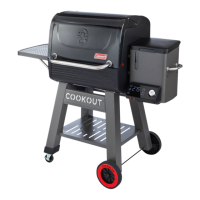
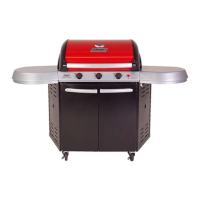
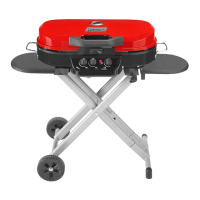

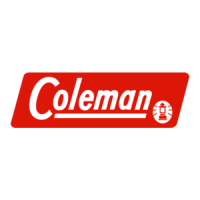
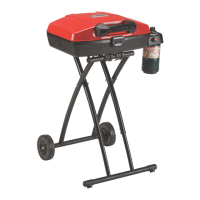

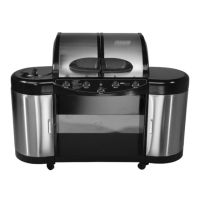

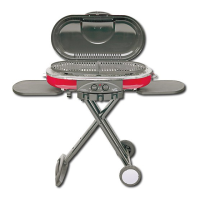
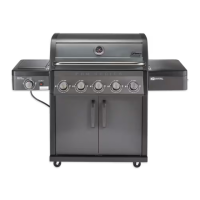
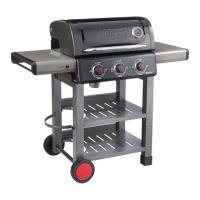
